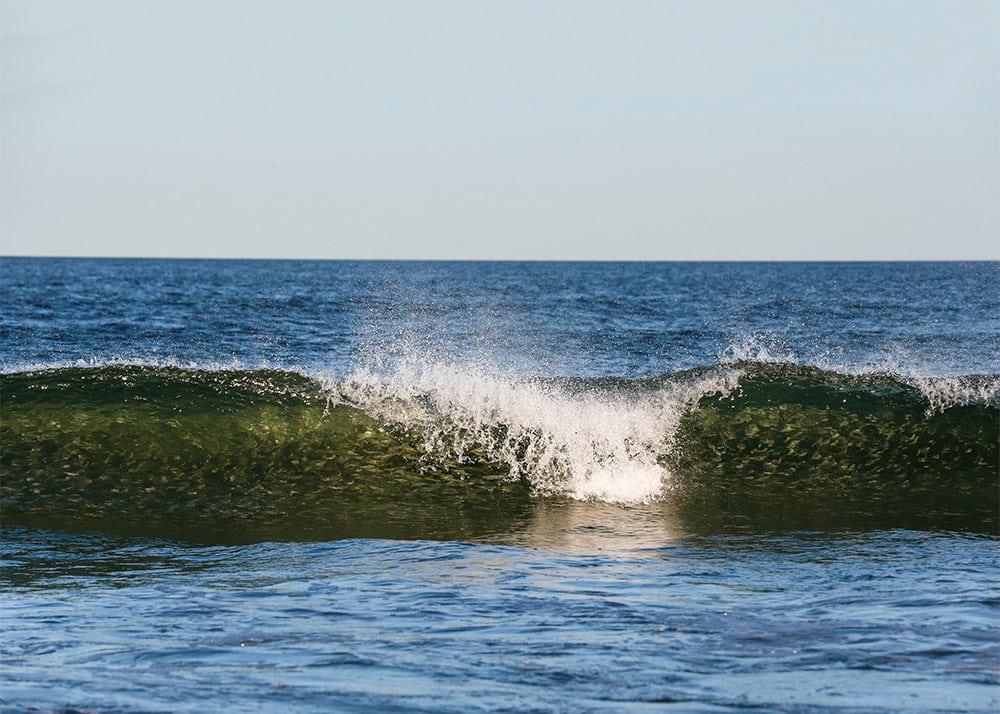
The morning was a washout. Nobody had caught any fish. I sat sipping coffee in the parking lot of a Jersey Wawa about noon when I got the call. “Get down to Seaside, man. Mullet are being destroyed,” said Charlie’s Bait and Tackle shop owner Pete Kupper.
I hit the road.
As I pulled up to the sand dunes, I saw gannets and gulls diving about and disappearing behind the dunes, a sure sign something was going on out there.
When I walked over, a vista of the Atlantic opened up in front of me encompassing mayhem the likes of which are the making of legend. Striped bass to 30 pounds and bluefish to 15 pounds were absolutely crushing mullet schools in and outside the breakers. It was an a-thousand-casts-a-thousand-bass type of day, all sparked by the run of silver mullet in the surf.
While more-southern waters have striped mullet crashing about in bombastic fashion, their smaller silver mullet cousins run along the Northeast and mid-Atlantic coasts in a more sublime fashion yet attract the same attention from predatory game fish.
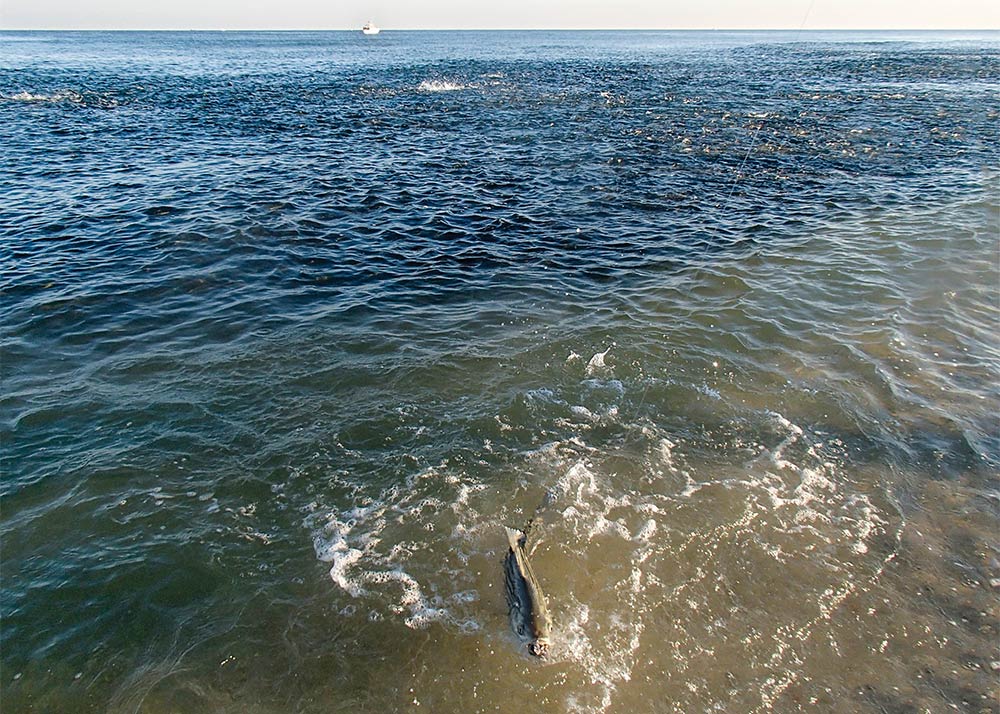
Jersey Tactics
During springtime, silver mullet fry about 1 to 2 inches long grow in the ditches of Jersey backwaters. By fall, they are finger-size, while full-grown year-old mullet seem to show up in July, riding the warmer oceanic currents that bring them inshore.
“Mainly, we see silver or white mullet up to 6 inches long; those are the bait mullet in tackle shops,” says Capt. Dave Showell of the Absecon Bay Sportsman. “Occasionally, we also get a few striped mullet, or corncobs, 8 to 12 inches long, but silver mullet are the main species in Jersey.”
From June through September, silver mullet stack up in shallow bays: Barnegat, Great Bay, Absecon and Cape May Harbor, where northwest winds keep them pinned against the sod banks as bluefish, striped bass and weakfish hammer the schools. Anglers jump on the chance to fish the schools in the bay before they head seaward.
It’s pretty easy to find schools of silver mullet,” Showell says. “Look for the pods V-waking in the shallow backwaters. The harder part is to get fresh ones to use as bait.”
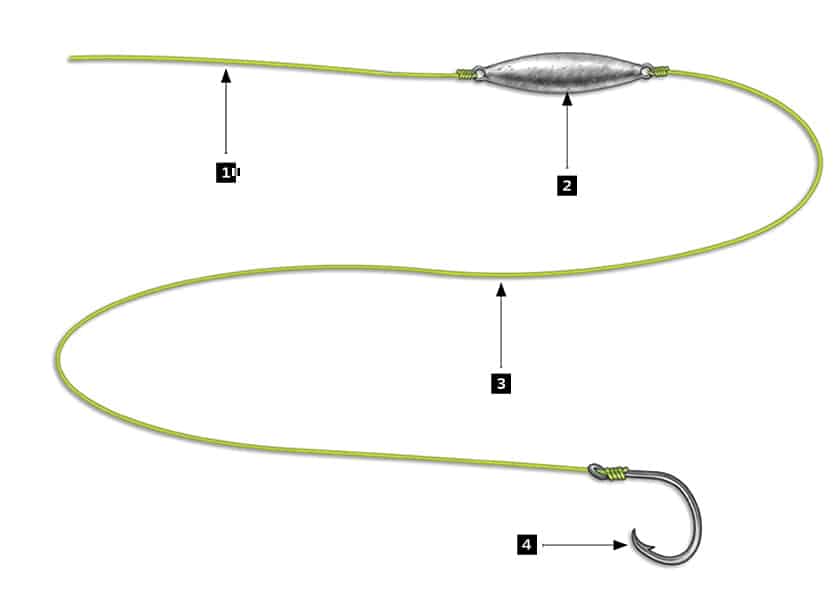
Midday Strategy
[2] In-line sinker
[3] 36 inches of 20- to 30-pound fluoro
[4] 3/0 to 6/0 Octopus circle hook Steve Sanford
To acquire the freshest baits, Showell recommends throwing a 3⁄8- to 1⁄2-inch mesh, 11⁄2-pound, 8-foot cast net on top of the schools when they are balled up. With fresh baits in the livewell, Showell employs a rig consisting of a 36-inch section of 20- to 30-pound fluorocarbon leader tied to a 1⁄2-ounce in-line sinker and a 3/0 to 6/0 Octopus circle hook, to settle the score with bass, blues and weakfish. Hook the mullet through the nose for a natural drift with the current.
“Now that you have the right bait, go with your knowledge to find each species,” Showell says. “Weakfish hang in the deep channels and points of confluence around sedge banks. Bass hold along the broken parts of sunken sod banks, and bluefish will inhale them in just about every channel.”
Though live bait always seem to work best when the sun is up, low-light hours offer the chance to work poppers or twitchbaits in a walk-the-dog style along the sod banks to bring bass off the cover.
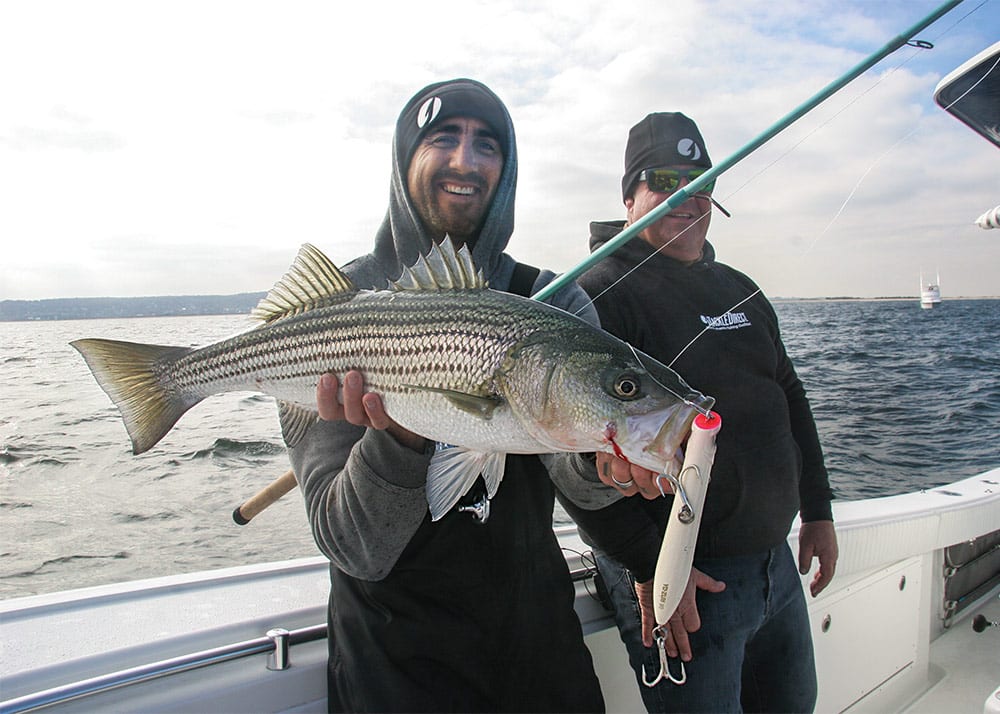
The first big chill after Labor Day signals it’s time for the mullet to make their exodus into the surf.
“Mid-September to early October, look for the full moon and air temps that dip into the 50s at night to spark the mullet movement out of the backwaters,” Showell says. “The trigger that gets them moving is usually the first fall nor’easter that comes through, which pushes them out of the back and into the surf almost overnight.” When mullet schools start to hug the coastline and choke the surf waters, successful surf fishermen toss Bomber A-Salt plugs and Daiwa SP Minnows along the stretch from Island Beach State Park down through Long Beach Island.
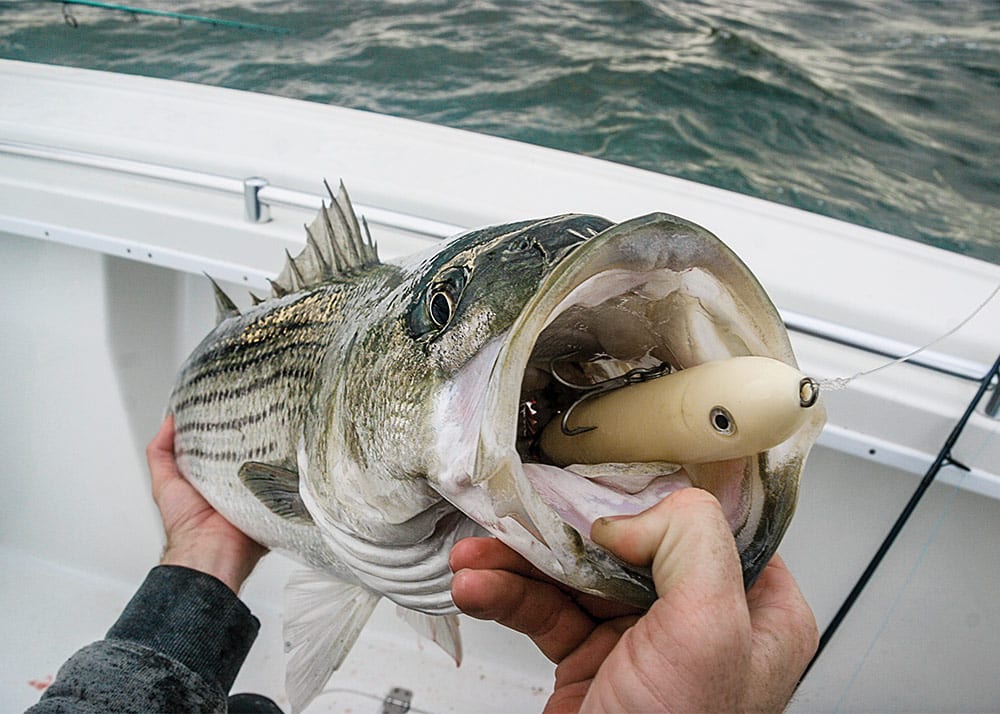
Carolina Castin’
“Silver and striped mullet are the main autumnal forage species for a wide variety of coastal species all along the North Carolina and mid-Atlantic coasts,” says Wayne Justice, a naturalist at the North Carolina Aquarium and an avid angler. “The big push in the fall occurs when the winds begin to switch to the northeast and bring cooler temperatures, which push the mullet out of our estuaries and into the ocean.”
Down in the Carolinas, the menu has changed to redfish, flounder and speckled trout where shorebound anglers and small boaters hug the coastline to pound the schools. The sheer numbers of mullet also draw speedsters such as Spanish mackerel and false albacore into the surf zone to take advantage of the abundant forage.
Read Next: Spring Mullet Run in the Southeast Kicks off the Season
“Along North Carolina’s southern-facing beaches around Cape Lookout and Shackleford banks, northeast winds lay the ocean down and offer reverse surf fishing for small boats,” Justice says. “Boaters set up outside the breakers and cast to the backs of the waves where mullet schools stack up. We often stick close to the jetties and piers, which seem to disorient the mullet and provide predators ambush opportunities.”
Justice employs a slider rig with a ½- to 1-ounce egg sinker on the running line, against a 75-pound barrel swivel, tied to 30 inches of 20- to 30-pound fluoro leader. Hook size depends on the target species: a 3/0 Kahle for flounder, and a 5/0 circle hook for red drum and bluefish. Speckled trout can be more discerning, thus scaling down to 15-pound fluorocarbon leader is recommended. When drift conditions are adverse, tip a light ¼- to ½-ounce jig head with a live mullet and cast around the jetty pilings or off the jetty rocks.
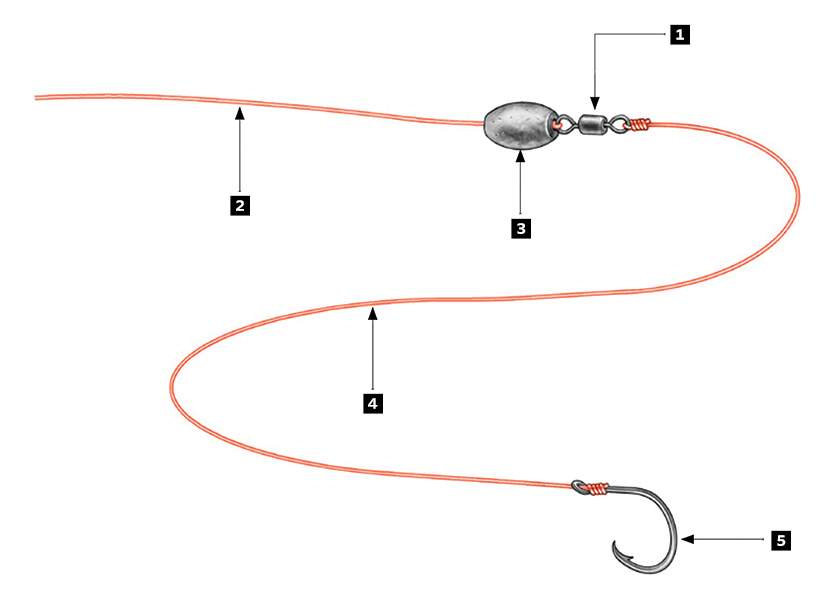
Carolina Slider Rig
[2] 1⁄2- to 1-ounce egg sinker
[3] 30 inches, 15- to 30-pound fluoro
[4] 3/0 Kahle or 5/0 circle hook Steve Sanford
Artificial lures to mimic mullet should have a dark back and lighter belly. “I’ll throw a chrome Rapala Skitterwalk when the fish are feeding up top but switch to a black-and-silver MirrOlure Catch 2000 when they are not on the surface,” Justice says. Soft plastics such as the 4-inch D.O.A CAL Jerk Shad or a Fathom Squirrely Tail Grub hit the mark to tempt reds, blues and specks. “Slow it down and hop it along the bottom,” he adds. If Spanish and false albacore are around, switch up to a 1-ounce gold Kastmaster spoon and rip it through the water.
Next time you feel the chill on your neck of impending fall kicking in, when oak and maple tree leaves start shifting their colors into reds, oranges and yellows, look for the shimmering, silvery V-waking schools of mullet to spill out of the bays and enter the Northeast and mid-Atlantic surf waters. It’s official: The fall run has begun.
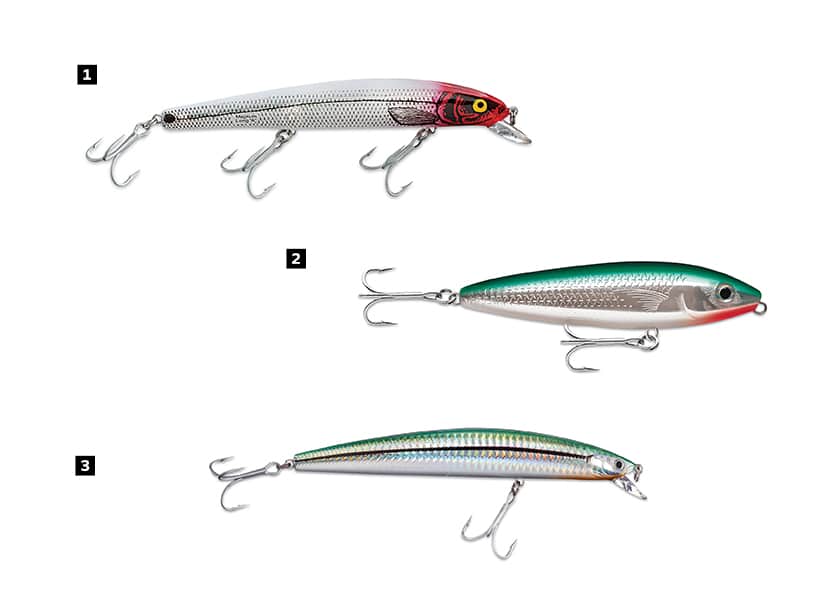
[2] Topwaters such as the Rapala Skitterwalk Salt Water do the trick on surface feeders.
[3] Shallow diving plugs, such as the Daiwa Salt Pro Minnow, remain a favorite in the surf. Courtesy Bomber, Rapala, Daiwa
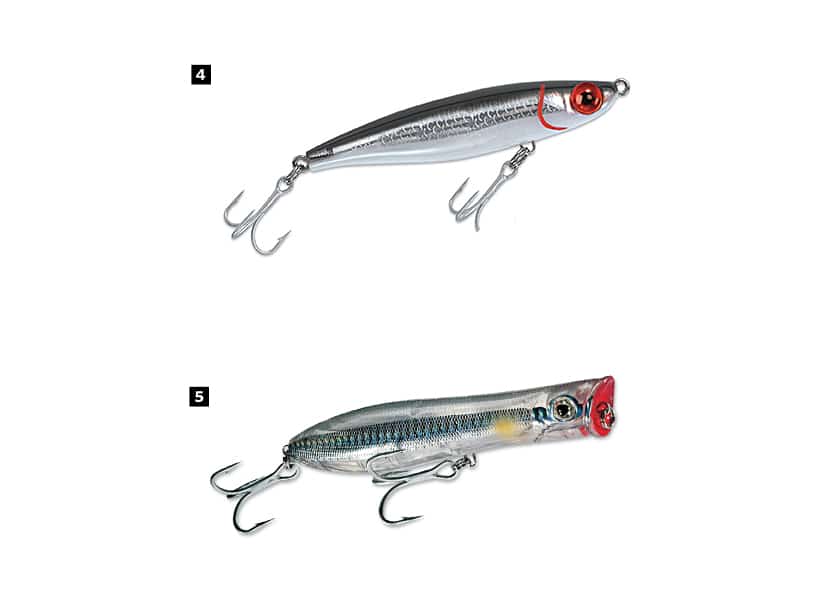
[5] When feeding erupts, try a surface chugger, such as the Tsunami Talkin’ Popper. Courtesy MirrOlure, Tsunami
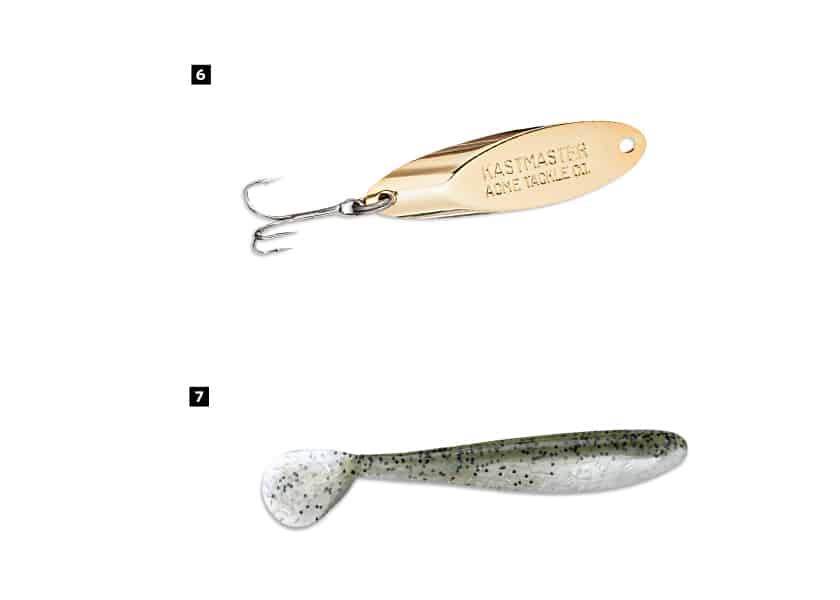
[7] Soft plastics, like D.O.A.’s CAL Shad Tail, with a lead-head are deadly when bumped along the bottom. Courtesy Kastmaster, D.O.A.
SWS Planner: Northeast and Mid-Atlantic Mullet Migration
What: Striped bass, bluefish, weakfish, summer flounder, redfish, speckled trout
Where: New York to North Carolina
When: September to November
Who: The mullet run provides ample opportunity for DIY anglers, from the back bays to the surf. For a fast track to learning the particulars:
Capt. Dave Showell
Absecon Bay Sportsman
609-484-0409
SWS Tackle Box: Northeast and Mid-Atlantic Mullet Migration
Rod: 7-foot medium weight
Reel: Shimano Stradic 5000 to 8000, or equivalent
Lures: MirrOlure Catch 2000, Bomber 16A, Daiwa SP Minnow, Rapala Skitterwalk, D.O.A CAL, Tsunami Talkin’ Popper
Line: 20- to 30-pound Spiderwire braid, 15- to 30-pound Seaguar fluorocarbon leader
Terminal Tackle: 75-pound Spro barrel swivel, fish-finder sinker slide, size 3/0 to 6/0 Gamakatsu Octopus hooks, 2- to 5-ounce bank sinkers









